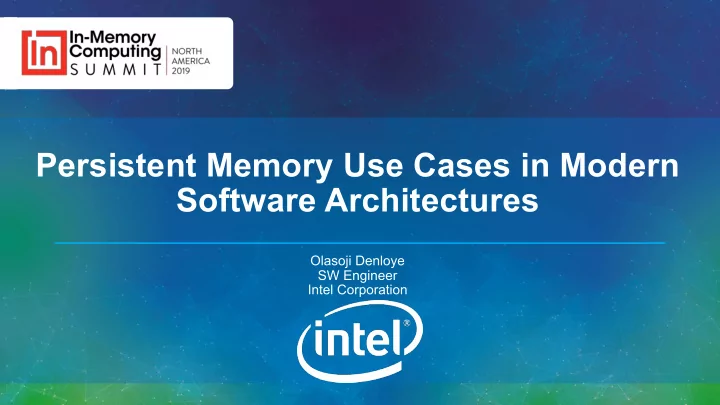

Persistent Memory Use Cases in Modern Software Architectures Olasoji Denloye SW Engineer Intel Corporation
Persistent Memory
3
Properties of Persistent Memory • Byte-addressable like DRAM • Direct user-level access • Lowers DRAM footprint • Works with both File and Memory APIs • Multiple Modes • Memory Mode - Persistent Memory as Main Memory • App Direct Mode - OS aware of Persistent Memory 4
The SNIA NVM Programming Model 5
Common Use Cases • Caches • Volatile Memory • Data structures for fast lookup • Persistent Memory • Stores • Device for persisting data • Buffers • Temporary data storage 6
Caches
Caches • Caches are fast and lightweight • Persistent Memory provides larger data structures capacities than DRAM • Typically live on DRAM for speed • Faster restart times • Constrained by DRAM size 8
HBase BucketCache - Manages buckets of memory containing fixed size blocks - Moved the cache from DRAM to Persistent Memory - Uses mapped file based allocator https://issues.apache.org/jira/browse/HBASE-21874 source: https://docs.cloudera.com/HDPDocuments/HDP3/HDP-3.1.4/hbase-data-access/content/overview-hbase-io.html 9
MemcacheD – DRAM - In memory Key-Value store DRAM - Used as a cache HashTable - Designed to be simple and fast Slab Slab Eviction 10
MemcacheD – Restartable Cache DRAM • Custom mapped file allocator • Hybrid data structure Hashtable - Hashtable on DRAM - Slabs on Persistent Memory • Restartable - Flush CPU caches on controlled shutdown - Rebuild Hashtable on restart Slab https://github.com/memcached/memcached/wiki/WarmRestart Slab Persistent Memory 11
Spark SQL Spark OAP (Optimized Analytics Platform) • OAP is a SparkSQL accelerator • IO cache • Uses Persistent Memory Development Kit (PMDK) : libvmemcache • Open source • Volatile LRU cache • Keys in DRAM, values on PMEM https://github.com/Intel-bigdata/OAP 12
Storage
Storage • Persists data • Persistent Memory is faster than NVME drives • Large capacity • No need for • Typically SSDs or HDDs serialization/deserialization • Update in place • Simpler code 14
Cassandra Write Path 15
Cassandra Read Path 16
Write Path – Persistent Memory Storage 17
Read Path – Persistent Memory Storage 18
Cassandra Pluggable Storage Engine API 19
Cassandra Persistent Memory Storage Engine • Uses open source components • Low level Persistence Library • PMDK • Adaptive Radix Tree • Pluggable engine • 6 - 8X speedups on reads and writes https://github.com/intel/cassandra- pmem 20
Considerations on Persistent Use of Persistent Memory • Data Integrity • On a controlled shutdown : flush caches • On an uncontrolled shutdown (e.g. power failure, crash): transactions • Concurrency • CAS + flush is not atomic • Fragmentation • Existing problem worsened by longer lived memory pools 21
Summary • Persistent memory is available and valuable • Upstreamed in open source projects • Multiple ways to extract value • No code change OR data structure redesign • Libraries available to help • PMDK suite • Low Level Persistence Library - Java • Memory Mapped files 22
Links Hbase Bucket Cache: https://issues.apache.org/jira/browse/HBASE-21874 MemcacheD: https://github.com/memcached/memcached/wiki/WarmRestart Spark OAP: https://github.com/Intel-bigdata/OAP Cassandra PMEM: https://github.com/intel/cassandra-pmem PMDK: https://pmem.io/pmdk/ Libvmemcache: https://github.com/pmem/vmemcache Low Level Persistence Library: https://github.com/pmem/llpl Adaptive Radix Tree: https://db.in.tum.de/~leis/papers/ART.pdf 23
Recommend
More recommend